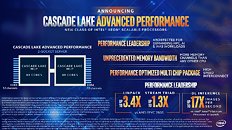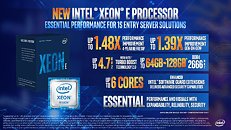Monday, November 5th 2018

Intel Announces Cascade Lake Advanced Performance and Xeon E-2100
Intel today announced two new members of its Intel Xeon processor portfolio: Cascade Lake advanced performance (expected to be released the first half of 2019) and the Intel Xeon E-2100 processor for entry-level servers (general availability today). These two new product families build upon Intel's foundation of 20 years of Intel Xeon platform leadership and give customers even more flexibility to pick the right solution for their needs.
"We remain highly focused on delivering a wide range of workload-optimized solutions that best meet our customers' system requirements. The addition of Cascade Lake advanced performance CPUs and Xeon E-2100 processors to our Intel Xeon processor lineup once again demonstrates our commitment to delivering performance-optimized solutions to a wide range of customers," said Lisa Spelman, Intel vice president and general manager of Intel Xeon products and data center marketing.Cascade Lake advanced performance represents a new class of Intel Xeon Scalable processors designed for the most demanding high-performance computing (HPC), artificial intelligence (AI) and infrastructure-as-a-service (IaaS) workloads. The processor incorporates a performance optimized multi-chip package to deliver up to 48 cores per CPU and 12 DDR4 memory channels per socket. Intel shared initial details of the processor in advance of the Supercomputing 2018 conference to provide further insight to the company's extended innovations in workload types.
Cascade Lake advanced performance processors are expected to continue Intel's focus on offering workload-optimized performance leadership by delivering both core CPU performance gains1 and leadership in memory bandwidth constrained workloads. Performance estimations include:
Small businesses deploying Intel Xeon E-2100 processor-based servers will benefit from the processor's enhanced performance and data security. They will allow businesses to operate smoothly by supporting the latest file-sharing, storage and backup, virtualization, and employee productivity solutions.Intel Xeon E-2100 processors are available today through Intel and leading distributors.
"We remain highly focused on delivering a wide range of workload-optimized solutions that best meet our customers' system requirements. The addition of Cascade Lake advanced performance CPUs and Xeon E-2100 processors to our Intel Xeon processor lineup once again demonstrates our commitment to delivering performance-optimized solutions to a wide range of customers," said Lisa Spelman, Intel vice president and general manager of Intel Xeon products and data center marketing.Cascade Lake advanced performance represents a new class of Intel Xeon Scalable processors designed for the most demanding high-performance computing (HPC), artificial intelligence (AI) and infrastructure-as-a-service (IaaS) workloads. The processor incorporates a performance optimized multi-chip package to deliver up to 48 cores per CPU and 12 DDR4 memory channels per socket. Intel shared initial details of the processor in advance of the Supercomputing 2018 conference to provide further insight to the company's extended innovations in workload types.
Cascade Lake advanced performance processors are expected to continue Intel's focus on offering workload-optimized performance leadership by delivering both core CPU performance gains1 and leadership in memory bandwidth constrained workloads. Performance estimations include:
- Linpack up to 1.21x versus Intel Xeon Scalable 8180 processor and 3.4x versus AMD EPYC 7601
- Stream Triad up to 1.83x versus Intel Scalable 8180 processor and 1.3x versus AMD EPYC 7601
- AI/Deep Learning Inference up to 17x images-per-second2 versus Intel Xeon Platinum processor at launch.
Small businesses deploying Intel Xeon E-2100 processor-based servers will benefit from the processor's enhanced performance and data security. They will allow businesses to operate smoothly by supporting the latest file-sharing, storage and backup, virtualization, and employee productivity solutions.Intel Xeon E-2100 processors are available today through Intel and leading distributors.








36 Comments on Intel Announces Cascade Lake Advanced Performance and Xeon E-2100
It was unprofessional to have "glued together" on the sliders but that statement was correct, and that made AMD CPUs cost effective but introduced many problems from having poor connection density between dies.
maybe this new technique will solve several issues in one fell swoop.
But, yeah, they will have to come up with some high bandwidth bus to connect future MCM products and it will be similar to IF :) and it will be internal to their chips. Unless they will do some serious magic with Mesh topology like it is rumored EPYC2 is using.
Put that into perspective for a moment. Amazon was exclusively Intel and now they're including AMD as an option for VMs in AWS. The more companies like Amazon that do that, the more it's going to hurt Intel. Intel has a stranglehold on the server market, but that also means that they have the most to lose.